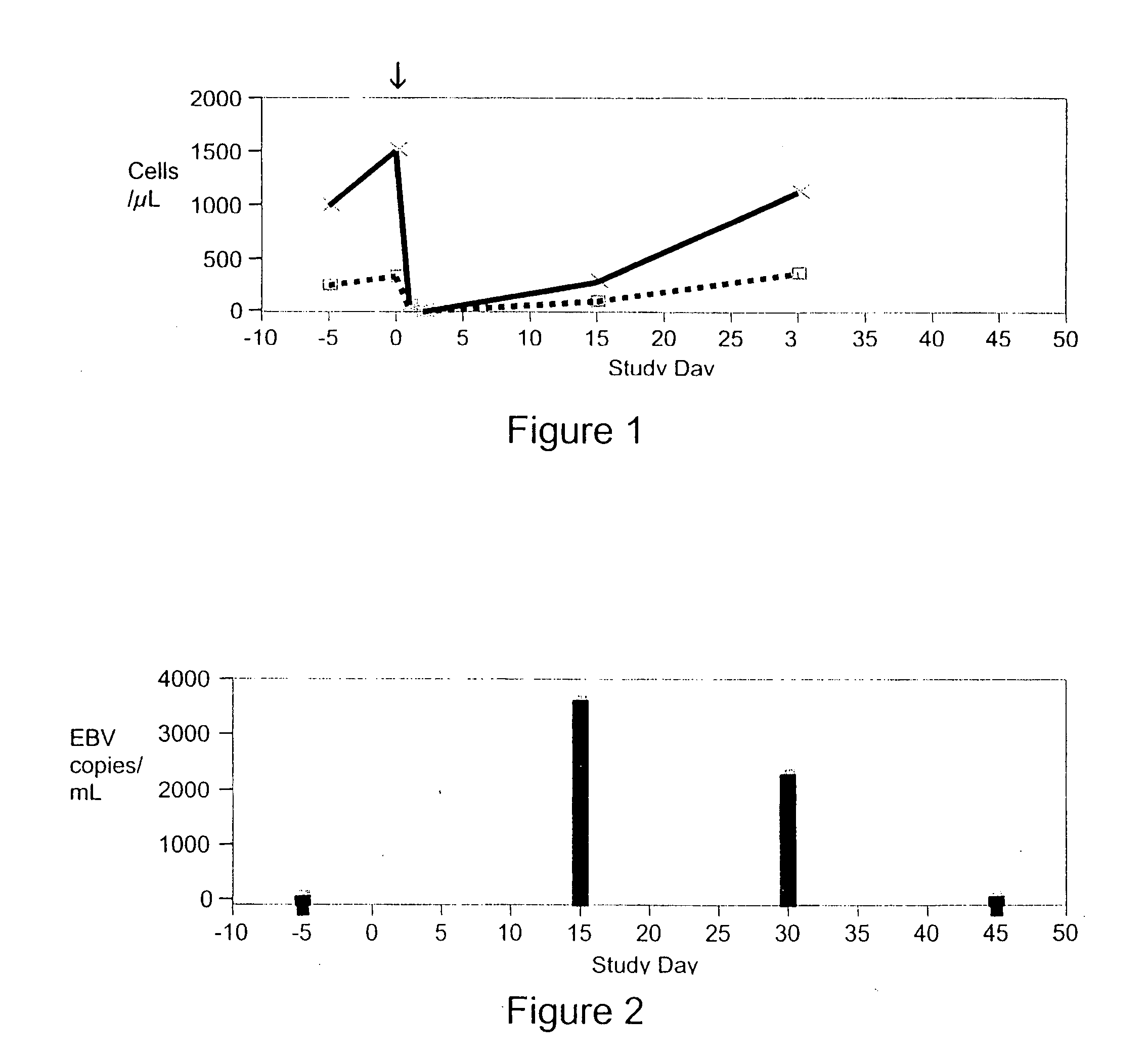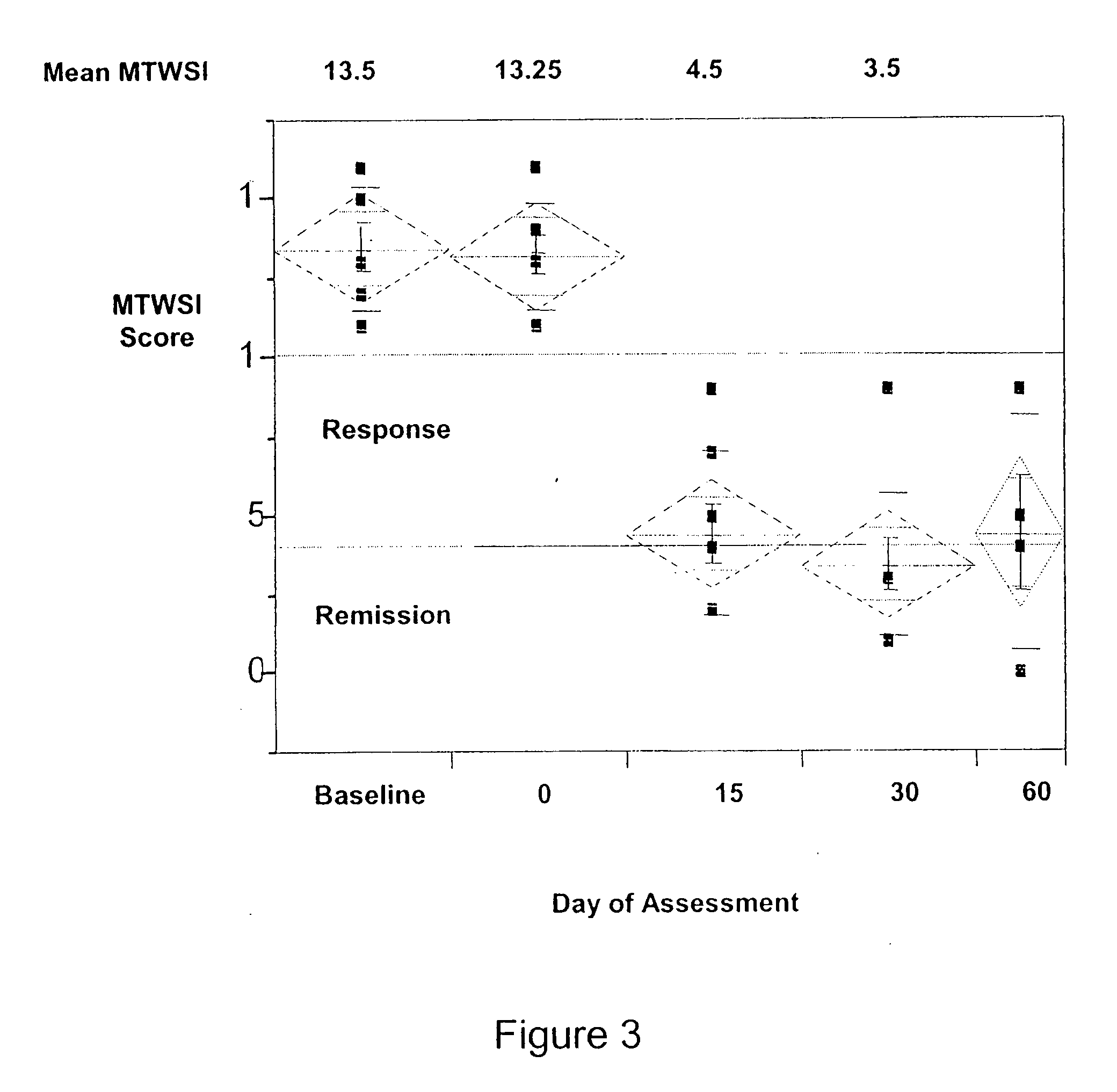Methods of treatment of Ulcerative Colitis and Crohn's disease with anti-CD3 antibodies
an anti-cd3 and crohn's disease technology, applied in the field of immunology and the treatment of autoimmune diseases, can solve the problems of no medical cure for uc, surgical procedure is potentially compromised, and long periods of remission with only minimal symptoms, and achieve the effect of inhibiting the proliferation or activation of t-cells
- Summary
- Abstract
- Description
- Claims
- Application Information
AI Technical Summary
Benefits of technology
Problems solved by technology
Method used
Image
Examples
example 1
[0075] This example describes the study synopsis of the Phase I, dose-escalation, pilot study of visilizumab in patients with severe ulcerative colitis that is refractory corticosteroids.
Study Synopsis
A Phase I, Dose-Escalation, Pilot Study of Visilizumab in Patients With Severe Ulcerative Colitis that is Refractory to Corticosteroids
[0076] Protocol Number: 291-406, Amendment B [0077] Phase: I [0078] Study Drug: Visilizumab (Nuvion®; HuM291) [0079] Indication: Ulcerative colitis [0080] Regulatory Status US IND No. 9443 [0081] Study Design [0082] Dose-escalation, pilot study designed to obtain safety, tolerability, and preliminary efficacy data. Two stages were planned for this study. In Stage 1, consecutive groups of up to 10 patients was treated with 2 IV doses of visilizumab at 4 escalating dose levels until the maximum tolerated dose (MTD) or Optimum Biological Dose (OBD) is reached. Dose escalation would not occur until Day 30 safety and efficacy data were obtained on all pat...
example 2
[0130] This example describes the detailed protocols of the Phase 1, dose-escalation, pilot study of visilizumab in patients with severe ulcerative colitis that is refractory corticosteroids.
1. OBJECTIVES OF STUDY
1.1. Primary Objective
[0131] To evaluate the safety and tolerability of visilizumab when administered to patients with severe ulcerative colitis that is refractory to steroids.
1.2. Secondary Objectives
[0132] 1) To determine the maximum tolerated dose (MTD) or optimum biological dose (OBD) of visilizumab in this study. [0133] 2) To obtain preliminary evidence of biological activity in this indication. This may be signaled by a decrease in the MTWSI score, or the Mayo Score (both of which reflect disease symptom severity), and by lowered incidence of surgical intervention. [0134] 3) To determine relationships between pharmacokinetics and pharmacodynamics of visilizumab, clinical response, and toxicity.
2. STUDY DESIGN AND METHODS
2.1. Design and Controls
[0135] This is a...
example 3
[0296] This example describes the results of humanized anti-CD3 monoclonal antibody, Visilizumab, for treatment of severe steroid-refractory ulcerative colitis in the first 10 patients.
[0297] In severe, steroid-resistant ulcerative colitis (UC), therapeutic approaches have been used to targeted T-cells to control inflammation. For example, cyclosporine is efficacious in this population over the short-term, but side effects limit its use. Humanized anti-CD3 monoclonal antibody, visilizumab (Protein Design Labs, Inc., Fremont, Calif.), which induces preferential apoptosis of activated T-cells in vitro, provides therapeutic benefit in UC.
[0298] Of the ten patients treated, eight were given a visilizumab dose of 15 μg / Kg and two were given a visilizumab dose of 10 μg / Kg. Of the ten, six were male and four were female. The age ranged from 33 years old to 70 years old. The median age was 46 years old. Of the disease extent, four had left sided UC and six had pancolitis UC. The MTWSI sco...
PUM
| Property | Measurement | Unit |
|---|---|---|
| Fraction | aaaaa | aaaaa |
| Dimensionless property | aaaaa | aaaaa |
| Dimensionless property | aaaaa | aaaaa |
Abstract
Description
Claims
Application Information
 Login to View More
Login to View More - R&D
- Intellectual Property
- Life Sciences
- Materials
- Tech Scout
- Unparalleled Data Quality
- Higher Quality Content
- 60% Fewer Hallucinations
Browse by: Latest US Patents, China's latest patents, Technical Efficacy Thesaurus, Application Domain, Technology Topic, Popular Technical Reports.
© 2025 PatSnap. All rights reserved.Legal|Privacy policy|Modern Slavery Act Transparency Statement|Sitemap|About US| Contact US: help@patsnap.com



